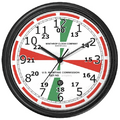SOS facts for kids
SOS (· · · — — — · · ·) is a special Morse code signal. It is used as a distress code to signal danger or ask for help. The German government first introduced it in their radio rules on April 1, 1905. It became a worldwide standard on July 1, 1908. This happened after many countries agreed to use it in a big meeting called the International Radiotelegraphic Convention.
The SOS distress signal is actually a continuous sound pattern. It's three short sounds (dits), followed by three long sounds (dahs), and then three more short sounds (dits). These sounds are all run together without any breaks. In International Morse Code, three dits make the letter S, and three dahs make the letter O. So, "SOS" became an easy way to remember the correct order of the sounds.
Many people think SOS stands for "Save Our Souls" or "Save Our Ship." While these phrases are popular, they were made up later. They act like a Mnemonic to help people remember the signal. In truth, the SOS signal doesn't stand for anything at all. It was chosen because it's simple and easy to recognize.
Many songs have been made about the SOS distress signal. Some famous ones include "Message in a Bottle" by The Police and "SOS" by ABBA. Other songs are "SOS" by Rihanna and "S.O.S." by the Jonas Brothers.
Contents
How SOS Developed
Before radio, ships used many ways to signal for help. They used flags, signal flares, bells, and foghorns. When radio communication, also called wireless telegraphy, started in the 1890s, it used Morse code. This was the same dit-and-dah system used for telegraphs on land.
There was a need for ships to have a standard way to communicate. But different countries and radio companies had their own ways of doing things. This made it hard to agree on one signal.
In 1903, countries met in Berlin, Germany, to talk about radio rules. An Italian representative suggested that ships in trouble should send "SSS DDD." But they didn't agree on a standard signal at that meeting.
Because there were no international rules, each ship used its own signals. For example, in 1905, a sinking ship near Nantucket sent the word "HELP." The Marconi company, a big radio company, introduced its own distress call in 1904. This signal was "CQD" ( — · — · — — · — — · · ).
Germany Creates SOS
The SOS distress signal was created in Germany. On April 1, 1905, the German government made new radio rules. These rules included a "Distress signal" called Notzeichen. This signal was the three-dits/three-dahs/three-dits (· · · — — — · · · ). It was meant to be repeated by a ship in trouble until other stations stopped sending.
SOS was chosen because it was easy to recognize and send quickly. Compared to the older "CQD" signal, SOS is much simpler. It also wouldn't be confused with "CQ," which means "calling anyone" in a casual way.
In 1906, countries met again in Berlin. They agreed to make Germany's distress signal the international standard. This rule became active on July 1, 1908. The first ship to send an SOS distress call was the Cunard liner Slavonia on June 10, 1909.
Even after SOS became the official signal, some radio operators still used "CQD." For example, during the sinking of the RMS Titanic in April 1912, the ship's operators sent both CQD and SOS calls. But after the Titanic disaster, it became very clear that everyone needed to use the same signal for safety. So, the use of CQD mostly stopped after that.
The SOS signal was always meant to be a continuous sequence of sounds. It was not meant to be sent as three separate letters with spaces in between. "SOS" just became a simple way to remember the pattern of nine dits and dahs. Today, when writing about this signal, it's often shown with a line over the letters, like SOS. This line shows that the sounds should be sent without any breaks.
SOS has also been used as a visual signal. People can flash three short, three long, and three short lights. Or they can spell out "SOS" using letters, like stamping them in snow or forming them with logs on a beach. The signal is easy to read even upside down, which is helpful if viewed from above.
Famous SOS Calls
Here are some famous ships that sent SOS calls:
Later Signals
Over time, other warning and distress signals were created. In 1914, the Morse code signal TTT ( — — —) was adopted. This "Safety Signal" was used for urgent messages about navigation safety.
When radio transmitters could send voices, a spoken distress phrase was needed. In 1927, "Mayday" was chosen as the spoken equivalent of SOS. For urgent safety messages, the spoken equivalent of TTT is "Pan-pan."
During the Second World War, more codes were used to give details about attacks.
- SSS meant attacked by submarines.
- RRR meant attacked by a surface ship.
- QQQ meant attacked by an unknown ship.
- AAA meant attacked by aircraft.
These codes were usually sent along with the SOS distress call. Later, these codes changed from three repeats of the letter to four repeats (like "RRRR").
Images for kids
See also
 In Spanish: SOS para niños
In Spanish: SOS para niños




